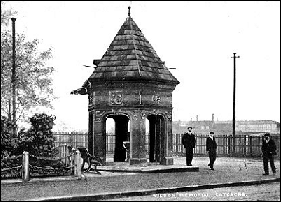|
|
|
|
|
|
|
|
|
|
|
|
|
|
|
|
|
|
|
|
|
|
|
|
A BRIEF HISTORY OF GATEACRE
(continued)
from the Gateacre Society, Liverpool
|
|
|
|
|
|
|
|
|
|
|
|
|
|
|
|
|
|
|
Another local resident was John Hays Wilson, a brassfounder who was also chairman of Liverpool town council's Water Committee. He died in 1881, having caught a chill at a horseracing meeting held in the grounds of his home, Lee Hall. The people of Gateacre paid for a picturesque memorial: the hexagonal sandstone structure (originally housing a drinking fountain) which remains a well-known local landmark on the corner of Grange Lane.
|
|
|
|
|
|
|

|
|
|
|
|
|
|
|
|
|
|
|
|
|
|
|
(Above:)
THE WILSON MEMORIAL,
Gateacre Brow/Grange Lane
|
|
|
|
|
|
|
|
|
|
|

|
|
|
|
|
|
|
|
|
|
|
|
|
It was Sir Andrew Barclay Walker who donated the land for the Wilson Memorial and who, at about the same time, gave the nearby Black Bull pub its 'mock Tudor' look. A few years earlier, in 1877, he had provided land in Halewood Road for a new Church of England school, and converted the old school building in Grange Lane into a reading room, later to become the Gateacre Institute. And it was Sir Andrew's son, William Hall Walker - later Lord Wavertree - who built stables for his polo ponies (now Grange Mews) in 1895, and 'model' houses (Soarer Cottages) for his married grooms in 1896 to commemorate his Grand National victory.
|
|
|
|
|
|
|
|
|
|
|
|
|
|
|
|
(Above:)
THE BLACK BULL, Gateacre Brow
|
|
|
|
|
|
|
|
|
|
|
|

|
|
|
|
|
|
|
|
|
|
|
|
|
|
|
|
|
|
|
|
|
(Left:)
SOARER COTTAGES, Grange Lane
(Below:)
WILLIAM HALL WALKER of Gateacre Grange
|
|
|
|
|
|
|
|
|
|
|
|

|
|
|
|
|
|
|
|
|
|
|
|
|
|
|
|
|
|
|
Page created 14 August 2005 by MRC, last updated 5 Feb 2022
|
|
|
|
|
|
|
|







